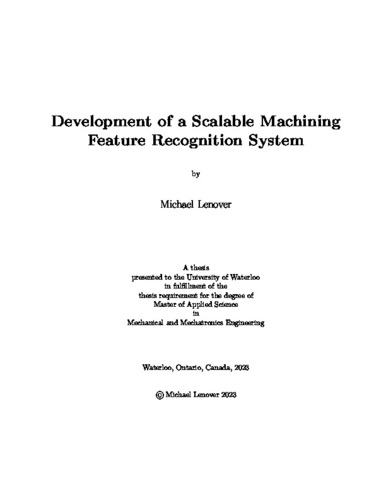UWSpace will be migrating to a new version of its software from July 29th to August 1st. UWSpace will be offline for all UW community members during this time.
Development of a Scalable Machining Feature Recognition System
| dc.contributor.author | Lenover, Michael | |
| dc.date.accessioned | 2023-12-19 14:23:25 (GMT) | |
| dc.date.available | 2023-12-19 14:23:25 (GMT) | |
| dc.date.issued | 2023-12-19 | |
| dc.date.submitted | 2023-12-13 | |
| dc.identifier.uri | http://hdl.handle.net/10012/20181 | |
| dc.description.abstract | In this thesis, various pre-processing and training techniques were applied to improve the performance of a model trained with an existing machining feature recognition approach by Yeo et al. using a smaller dataset that more effectively mimics the complexity of CAD models used in industry. A GUI tool was developed to tag faces in CAD models with the corresponding machining features which would be necessary to resolve those faces. Using the encoding algorithm outlined by Yeo et al., a tool was developed to generate feature vectors from tagged CAD models. Two CAD datasets were compiled. First, a dataset of generic CAD models was filtered from a larger dataset compiled by Koch et al., selecting those models which could be manufactured using a 3-axis CNC machine. Second, a dataset of real-world CAD files used in CNC manufacturing was compiled from models contributed by individuals from the Unviersity of Waterloo, Hurco Inc. and Perfecto Inc. Using the first dataset, three potential improvements to the feature recognition algo- rithm developed by Yeo et al. were explored: the incorporation of dropout to improve model stability and accuracy, the incorporation of ID3 tree pre-classification to reduce training time by reducing the size of the deep learning dataset without impacting classification accuracy, and the incorporation of crossover data generation to improve classification ac- curacy by reducing overfitting due to insufficient training data. It was determined that incorporating dropout improved the stability of the model and improved 5-fold cross val- idation accuracy. Further, it was determined that incorporating a 2-deep ID3 decision tree pre-classification marginally improved classification performance and was effective in reducing the size of deep learning training dataset. Crossover data generation did not improve model performance, and so was rejected. Using the model trained on the generic CAD dataset, and incorporating 10% dropout and a 2-deep ID3 tree, models from the real-world dataset were classified. This classifier was effective in classifying some simple features, but had poor accuracy overall. To improve this accuracy, an incremental learning technique was applied. The generic model was re-trained using samples from the real-world dataset, which improved the classification accuracy of the system. | en |
| dc.language.iso | en | en |
| dc.publisher | University of Waterloo | en |
| dc.relation.uri | https://github.com/mlenover/machining-feature-recognition | en |
| dc.subject | cnc | en |
| dc.subject | cam | en |
| dc.subject | machine learning | en |
| dc.subject | machining feature recognition | en |
| dc.title | Development of a Scalable Machining Feature Recognition System | en |
| dc.type | Master Thesis | en |
| dc.pending | false | |
| uws-etd.degree.department | Mechanical and Mechatronics Engineering | en |
| uws-etd.degree.discipline | Mechanical Engineering | en |
| uws-etd.degree.grantor | University of Waterloo | en |
| uws-etd.degree | Master of Applied Science | en |
| uws-etd.embargo.terms | 0 | en |
| uws.contributor.advisor | Bedi, Sanjeev | |
| uws.contributor.advisor | Mann, Stephen | |
| uws.contributor.affiliation1 | Faculty of Engineering | en |
| uws.published.city | Waterloo | en |
| uws.published.country | Canada | en |
| uws.published.province | Ontario | en |
| uws.typeOfResource | Text | en |
| uws.peerReviewStatus | Unreviewed | en |
| uws.scholarLevel | Graduate | en |

